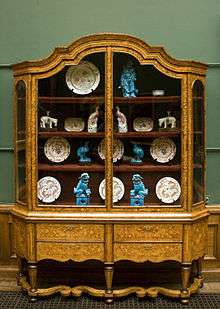China cabinet
A china cabinet is a piece of dining room furniture, usually with glass fronts and sides, used to hold and display porcelain dinnerware (china). Typical china held in such cabinets often includes cups, plates, bowls, and glasses. Along with a table, chairs, and a sideboard, the china cabinet is one of the most typical elements of a traditional dining room in the Western world.[1]

Aspects
China cabinets are typically placed against a wall, opposite the door or windows. They are often set in a conspicuous place where china, silverware, and glassware can easily be seen by guests and accessed by the host.[1]
There is an innumerous number of forms for china cabinets, as sizes, shapes, and construction methods may vary.[2] Traditional china cabinets have shelves lined with silk or velvet, or can have glass shelves.[2]
History
China cabinets are objects designed to meet a specific need: the collection and display of porcelain dinnerware from the Orient along with other items of interest, a pursuit that gained popularity in the late 17th century.[3]
China cabinets were introduced to England in the end of the 17th century, when china collection became popular. William and Mary's reign particularly popularized the furniture and porcelain, as Queen Mary was known for collecting Chinese pottery. Early cabinets were simply designed, often made of walnut. Dutch cabinets began being imported in the late 1600s and early 1700s, and thus English-made cabinets began being influenced by Dutch design. By the middle of the 18th century, china cabinets were typically more elaborate; later cabinets had especially elaborate doors and were lighter weight.[4]
See also
References
- Living and Learning in Home Economics. p. 25. Retrieved September 11, 2018.
- Modern Cabinetwork, Furniture & Fitments. pp. 166–8. Retrieved September 11, 2018.
- Conservation of Furniture. p. 16. Retrieved September 11, 2018.
- English Furniture at a Glance. p. 44. Retrieved September 11, 2018.
External links
